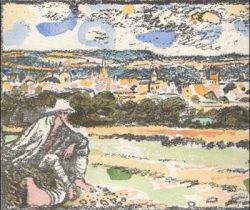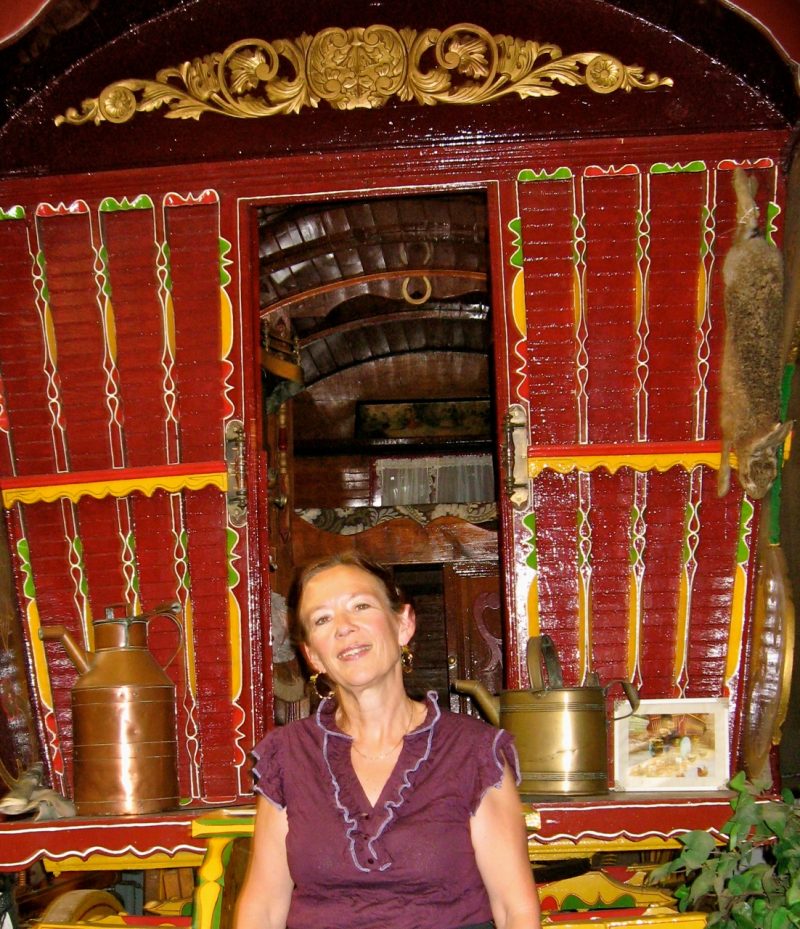#402 Roma and other Gypsies
Gypsy Fugue: An Archetypal Memoir
by Marlene Schiwy
Halfmoon Bay: Caitlin Press, 2018
$24.95 / 9781987915594
Reviewed by Phyllis Reeve
First published October 18, 2018
*
Readers might recall The Manticore (1972), the second in Robertson Davies’ Deptford Trilogy, in which David Staunton dreams of a gypsy the night before starting Jungian therapy in Zurich. One reviewer called Davies’ novel “an engrossing primer on the precepts of Carl Jung” (Geoffrey James, “Mystic of Massey College,” The Times, 21 May 1973, p. 9).
Archetypes, a central concept of Jungian analytical psychology, continue to provide fertile ground for Canadian writers. In Gypsy Fugue: An Archetypal Memoir, Marlene Schiwy identifies and explores the gypsy archetype in her own life and work. While Ormsby reviewer Phyllis Reeve is troubled by possible confusion between Schiwy’s gypsy archetype and “a real ethnic group,” the Roma, she also finds that “Schiwy writes enchantingly about her archetype, interweaving dreams, patterns, themes, even embroidery, with fragments of autobiography, all the while channelling her inner gypsy.” — Ed.
*
 This book is not about gypsies — at least I don’t think it is. It is about archetypes, which are defined by C.G. Jung, quoted by Marlene Schiwy, as “a priori inborn forms … complexes of experience that come upon us like fate, and their effects are felt in our most personal life.” Schiwy continues, “If we approach them with curiosity and awe, they imbue our lives with mythic depth, and connect us with a vast ocean of meaning.”
This book is not about gypsies — at least I don’t think it is. It is about archetypes, which are defined by C.G. Jung, quoted by Marlene Schiwy, as “a priori inborn forms … complexes of experience that come upon us like fate, and their effects are felt in our most personal life.” Schiwy continues, “If we approach them with curiosity and awe, they imbue our lives with mythic depth, and connect us with a vast ocean of meaning.”
We’ll come back to that mythic depth, as Schiwy explores her personal archetype, the gypsy, distinguished with italics from the Gypsy (Roma) people and the gypsy stereotype of popular culture. (I have retained Schiwy’s gypsy in italics to signify her archetype).
Schiwy lays out her boundary-crossing intentions: “Gypsy Fugue crosses the boundary between memoir and personal essay, blends Jungian scholarship and ethnographic research, blurs the border between concrete and imaginal, discursive and poetic, and between the inner and outer realities that make up our lives.”
According to her website,[1] Marlene Schiwy “taught English Literature, Creative Writing, and Women’s Studies for many years in London and New York, and has been teaching at the University of British Columbia’s Writing Centre since 2000. She has conducted writing workshops, Jungian study seminars, professional development seminars, and ongoing writing circles in Canada, the US, and Europe for close to three decades.”

There is solid background here, and her academic credentials have me sadly beaten. She is a trained pianist and soprano — hence the “fugue” in the book’s title and structure — especially drawn to Bach, “as if his music were known to me before I was born.” She leads soul-writing workshops and a program of Body Soul Sundays. Her journals, kept since she was eleven years old, run to almost 200 volumes.
She has continued in close contact with her Jungian mentors, the late Marion Woodman, who guided her in the exploration of images alive in her body and soul, and James Hillman, who imagines archetypes as “the deepest patterns of psychic functioning.”
As noted above, this is a “depth memoir,” embracing, for instance, what Schiwy calls deep song, deep self, deep emotion, deep way, deep counsel, deep gratitude, deep psyche, deep wounds, deep feminine, deep way, deep centre, entering more deeply into the bodies of our images. When counselling, the author aims for “the depths of the client’s psyche.”

She would like to identify with Matthew Arnold’s poem The Scholar Gypsy (1853) who wandered till he died. She does not mention George Borrow’s Lavengro: The Scholar, The Gypsy, The Priest (1851) or The Romany Rye (1857), my touchstones for everything Roma, or the Canadian poet Bliss Carman, whose “Vagabond Song” (1894) is never far from my mind as I look up from my desk and out the window at a Canadian autumn: “There is something in October sets the gypsy blood astir;/ We must rise and follow her,/ When from every hill of flame/ She calls and calls each vagabond by name.”
Schiwy’s gypsy is not meant to be a literary trope. “There is a gypsy in my soul,” she explains, “an inner image.” She subtitles her book an archetypal memoir “to express my sense of connection with a broader, deeper realm of meaning and significance than my own life could encompass, and to acknowledge the power of mythic patterns and images that shape our lives like invisible magnets, permeating us with particular passions, prejudices, and proclivities”.

As a 1960s era student of English and comparative literature, I have been chasing archetypal patterns for a lot of decades, with the help of such authorities as Maud Bodkin.[2] I like reading about archetypes, and Marlene Schiwy writes enchantingly about her archetype, interweaving dreams, patterns, themes, even embroidery, with fragments of autobiography, all the while channelling her inner gypsy.
A problem arises when you choose your own archetype and your choice is not a pattern like the wanderer or the hanged man or a myth like Oedipus or Daedalus, not someone from the Greek pantheon or the Tarot pack, but a real ethnic group. Schiwy invokes the Dark Sisters, witch, gypsy, and crone, but the witch and the crone are generic while the gypsy is specific and real.
She is aware of the shadow of cultural appropriation and devotes several chapters to an overview of Roma history and culture, with an extensive disclaimer:

My sincere hope is that this brief introduction might be read as a respectful acknowledgement of the distinction between a vibrant people whose lives have been obscured by prejudice and endless misrepresentation and who continue to suffer discrimination — and an inner soul image. The last thing I want to do is contribute to a further misrepresentation of the Roma people…. And I have tried to distinguish as clearly as possible among the actual conditions of Roma life, the prevailing gypsy stereotypes, and what I am referring to as the archetypal gypsy….
But does she succeed? Is it even possible to separate her gypsy archetype from the gypsy stereotype at a costume party? Especially when the inner gypsy turns outward, inspiring her to adopt hoop earrings and flashy skirts as everyday wear? Why should it be acceptable to borrow an archetype from the Gypsies and not from another culture? If she had felt drawn to an archetype from the forest primeval, would she — for example — appear in public as Minnehaha in fringed buckskins with a feather in her hair?
Her few encounters with actual Gypsies seem to have been cordial enough. Perhaps they found her a minor irritant compared with the widespread “gypsy industry.”[3] Online from Texas, a place called Pink and Silver Fashions advertises “everything for your gypsy-boho soul,”[4] which sounds like fun; but a gypsy-boho [bohemian?] soul is not just harmless playacting, a soul being dangerously close to a place where archetypes lurk.

Meanwhile, the real Roma in Canada are preoccupied with nurturing their community and assisting those who come as refugees from very real persecution.[5]
“Would it be presumptuous,” she asks, “… to imagine archetypal memoir as a vehicle for the conveyance of new material, and the gypsy as its perfect Dionysian exemplar?” Would it? I honestly don’t know.
I believe she tries to be sensitive, and I believe her archetype is dear to her, but Marlene Schiwy and her gypsy leave me deeply uncomfortable. I enjoy her description of the gypsy’s dark gaze, but I am just not sure that gaze is “looking out from behind” the author’s eyes.
*

Phyllis Parham Reeve has written about local and personal history in her three solo books and in contributions to journals and multi-author publications. She also contributed the foreword to Charlotte Cameron’s play, October Ferries to Gabriola (Fictive Press, 2017). She is a contributing editor of the Dorchester Review and her writing appears occasionally in Amphora, the journal of the Alcuin Society. A retired librarian and bookseller and co-founder of the bookstore at Page’s Resort & Marina, she lives on Gabriola Island, where she continues to interfere in the cultural life of her community. More details than necessary may be found on her website: https://sites.google.com/site/phyllisreeve/
*
The Ormsby Review. More Books. More Reviews. More Often.
Publisher and Editor: Richard Mackie
The Ormsby Review is a journal service for in-depth coverage of BC books and authors in all fields and genres. The Advisory Board consists of Jean Barman, Wade Davis, Robin Fisher, Cole Harris, Hugh Johnston, Kathy Mezei, Patricia Roy, Maria Tippett, and Graeme Wynn. Scholarly Patron: SFU Graduate Liberal Studies. Honorary Patron: Yosef Wosk. Provincial Government Patron since September 2018: Creative BC
“Only connect.” – E.M. Forster
*
Endnotes:
[1] https://www.marleneschiwy.com/about-marlene/
[2] Maud Bodkin, Archetypal Patterns in Poetry: Psychological Studies of Imagination (London: Oxford University Press, 1934).
[3] https://gypsyindustry.wordpress.com/
[4] https://www.wearesigny.com/blog/?offset=1451540760000
[5] https://www.romatoronto.org/

